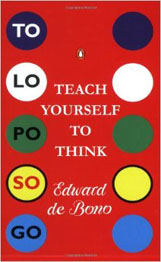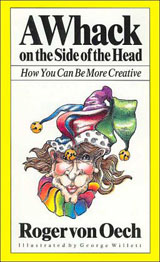
Realize it or not, Brilliant Ideas require a Provocation to start the idea generation process. Everyone has their own opinion about brainstorming. Some think it’s a powerful creativity tool. Others think it’s simply our brains playing around. It’s based on the concept that “two heads are better than one” to come up with new ideas that are Brilliant.
The current term “Brainstorming” has become easily confused with any creativity or innovation method. Many people use it as a way to describe the activity of coming up with any new idea, and very few understand the history of the term or its true intent.
Alex F. Osborn authored the original term “Brainstorming” in the 1953 book Applied Imagination. He used it to describe his early 1939 group-thinking efforts using the “brain to storm” a creative problem, and to do so in commando fashion, with each stormer attacking the same objective. Osborn additionally identified nine principles to manipulate a subject. The first two principles contribute to “ideative efficacy,” these being:
- Defer judgment
- Reach for quantity
- Reduce social inhibitions among the group members
- Stimulate idea generation
- Increase the overall creativity of the group
- Focus on quantity
- Withhold criticism
- Welcome unusual ideas
- Combine and improve ideas
Almost all current innovation and creativity processes use these same principles and goals as the objectives to create new ideas. One new area of idea exploration is the development of a “Provocation” challenge or statement which can take you into a non-traditional thinking direction. Bob Eberle developed the mnemonic. SCAMPER from Osborn’s original work and it was popularized in the “Thinker Toys” book by Michael Michalko.
- Substitute
- Combine
- Adapt
- Modify/Magnify
- Put to another use
- Eliminate
- Reverse/Rearrange
“It is easier to tone down a wild idea than to think up a new one.”- Alex Osborn
The solution, as suggested by the above quote, is to think up as many ideas as possible regardless of how ridiculous they may seem at first. Since it is very unlikely to think up the best solution immediately, we recommend getting every idea out of your head and then going back to examine them afterwards. An idea that may have initially sounded off-the-wall may actually turn out to be a potentially possible idea with some fine tuning or modification. Osborn’s technique of deferred judgment increases the individual’s synthesis capabilities by releasing the human mind from the analysis mode of thinking.
The most important step in brainstorming is formulating or creating the problem or challenge statement. This initial step leads idea creating participants into areas they may not traditionally go to. An “Idea Provocation” is a statement which challenges participants to immediately think differently. It can allow you to challenge or eliminate your assumptions. There are 4 categories of Provocations that can revolutionize your thinking which are based on:
- Timing – Time domains that can be challenged are to think into the future or the past for ways to stimulate new ideas or solve problems. You can slow down, stop, speed up or start over creating new situations, or logical mindsets. Time travel can exist and you can let it lead your thinking forward and into an outrageous direction.
- Arrangement – The logical flow for how things are joined together, connected, interconnected or placed is challenged. You can eliminate, rearrange, substitute or add something extra to stimulate new ideas or solve problems. The addition of splitting or fracturing the sequencing of your new thinking can lead to different, amazing new discoveries that naturally unveil themselves.
- Positional – Space domains are based on a logical position which can be challenged by working from the back to the front, turning things inside out and changing the direction to stimulate new ideas or solve problems. The starting point and ending points can be changed in the design or idea creation. When you think backward moving towards the initial starting point you can optimize your efficiency and maximize your effectiveness.
- Exploration – Breaking apart the basic assumptions, mental models and paradigms that structure the problem to your solutions is key to creating new idea mindsets. You can add abstract statements or elements together to create new thinking. Additionally, you can continue to question the thinking logic by repeatedly asking “Why” or “What’s stopping you.” Wicked problems are based on contradictions where two opposing elements are needed at the same time. True exploration looks to all areas that may contain new ideas or solve problems.
Brainstorming tools that can help you create these logical provocations are available from Edward de Bono in his lateral thinking tool PO (provocation operation) which can allow a fantasy idea by stating “wouldn’t it be nice if”. Roger Von Oech has developed a set of 64 cards called the Creative Whack Pack which can stimulate new creative strategies. Finally, Michael Michalko has designed a brainstorming card deck called THINKPAK which can lead to new insights using scamper questions and idea stimulators.
Using Idea Provocations allows a new creative balancing of a problem. The outrageous bold statements allow you to invert your thinking. The process of diverting your patterns of thinking with new problem or challenge statements can change the relationship of elements and flows. Ultimately this can allow you to create new and creative ideas for your business and enterprise challenges in 2014.
References
- THINKPAK – http://www.amazon.com/Thinkpak-Brainstorming-Card-Michael-Michalko/dp/1580087728
- Creative Whack Pack – http://www.amazon.com/Creative-Whack-Pack-Roger-Oech/dp/0880793589/ref=sr_1_1?s=books&ie=UTF8&qid=1392940692&sr=1-1&keywords=creative+Whack+Pack
- PO – http://www.debonogroup.com/serious_creativity.php



